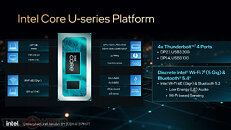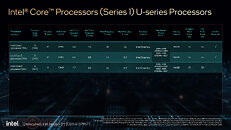- Joined
- Oct 9, 2007
- Messages
- 47,164 (7.57/day)
- Location
- Hyderabad, India
| System Name | RBMK-1000 |
|---|---|
| Processor | AMD Ryzen 7 5700G |
| Motherboard | ASUS ROG Strix B450-E Gaming |
| Cooling | DeepCool Gammax L240 V2 |
| Memory | 2x 8GB G.Skill Sniper X |
| Video Card(s) | Palit GeForce RTX 2080 SUPER GameRock |
| Storage | Western Digital Black NVMe 512GB |
| Display(s) | BenQ 1440p 60 Hz 27-inch |
| Case | Corsair Carbide 100R |
| Audio Device(s) | ASUS SupremeFX S1220A |
| Power Supply | Cooler Master MWE Gold 650W |
| Mouse | ASUS ROG Strix Impact |
| Keyboard | Gamdias Hermes E2 |
| Software | Windows 11 Pro |
Intel's current generation mobile processor product stack is vast, to say the least. In Q4-2023, the company launched its Core Ultra "Meteor Lake" mobile processors spanning the U-segment (7 W to 28 W), and H-segment (35 W to 45 W). Today, the company capped the upper end of the stack with the 14th Gen Core HX-series mobile processors based on "Raptor Lake Refresh," which dial up core counts to 8P+16E. And now, the company is adding more choice to the U-segment with the Core Processor Series 1, based on a lower core-count variant of the "Raptor Lake Refresh" architecture.
The Core Processor Series 1 follows the same nomenclature as the Core Ultra, where the "Ultra" denotes the latest "Meteor Lake" architecture. Processor model numbering and case badges are similar between Core Processor Series 1 and Core Ultra, except the lack of the "Ultra" brand extension. These chips are built on the monolithic "Raptor Lake Refresh" dies on the Intel 7 foundry node, and lack innovations such as the Low-power Island cores, 3D Performance Hybrid architecture, the all important AI Boost and on-silicon NPU; as well as that 2x faster Arc Xe-LPG integrated graphics, but use existing combinations of "Raptor Cove" and "Gracemont" CPU cores, along with older Xe-LP graphics with up to 96 EU; and a mostly similar I/O.



The Intel Core Processor 1 series U-segment is based on the smallest variant of "Raptor Lake Refresh," which physically features a 2P+8E core configuration. Each of the two P-cores has 1.25 MB of L2 cache, each of the two E-core clusters has 2 MB of L2 cache; while the two P-cores and E-core clusters share a 12 MB L3 cache. The PCIe interface is truncated, too. The CPU die puts out two PCIe Gen 4 x4 connections that are meant for NVMe storage devices, while the on-package PCH die puts out just 12 PCIe Gen 3 lanes. Notebook designers can implement Thunderbolt 4 with up to four ports. The platform also gets Wi-Fi 7 and Bluetooth 5.4 using discrete WLAN cards. The memory interface is dual-channel DDR4, dual-channel DDR5, and LPDDR5(x) at speeds of up to 5200 MT/s. All three processor models Intel is launching today feature a base power of 15 W, and a maximum turbo power of 55 W.
The three processor models are Core 7 150U, Core 5 120U, and Core 3 100U. Both the 150U and 120U get a maxed out core configuration of 2P+8E with 12 MB of L3 cache, but differ with clock speeds and iGPU configuration. The 150U ticks at up to 5.40 GHz boost for the P-cores, and up to 4.00 GHz boost for the E-cores, with a maxed out iGPU that has 96 EU (6 Xe cores) clocked at 1.30 GHz.
The Core 5 120U has the same 2P+8E CPU core configuration, but clocked lower than that of the 150U. The P-core boost is set at up to 5.00 GHz, and the E-core boost at 3.80 GHz. The iGPU is cut down to 80 EU (5 Xe cores), and clocked at 1.25 GHz. The Core 3 100U gets the same iGPU configuration as the 120U, but its CPU core count is cut down to 2P+4E, L3 cache reduced to 10 MB, and CPU core clock speeds lowered—up to 4.70 GHz for the P-cores, and up to 3.30 GHz for the E-cores.
Notebooks based on the Core U-series (100U) should begin rolling out within Q1-2024.
View at TechPowerUp Main Site
The Core Processor Series 1 follows the same nomenclature as the Core Ultra, where the "Ultra" denotes the latest "Meteor Lake" architecture. Processor model numbering and case badges are similar between Core Processor Series 1 and Core Ultra, except the lack of the "Ultra" brand extension. These chips are built on the monolithic "Raptor Lake Refresh" dies on the Intel 7 foundry node, and lack innovations such as the Low-power Island cores, 3D Performance Hybrid architecture, the all important AI Boost and on-silicon NPU; as well as that 2x faster Arc Xe-LPG integrated graphics, but use existing combinations of "Raptor Cove" and "Gracemont" CPU cores, along with older Xe-LP graphics with up to 96 EU; and a mostly similar I/O.



The Intel Core Processor 1 series U-segment is based on the smallest variant of "Raptor Lake Refresh," which physically features a 2P+8E core configuration. Each of the two P-cores has 1.25 MB of L2 cache, each of the two E-core clusters has 2 MB of L2 cache; while the two P-cores and E-core clusters share a 12 MB L3 cache. The PCIe interface is truncated, too. The CPU die puts out two PCIe Gen 4 x4 connections that are meant for NVMe storage devices, while the on-package PCH die puts out just 12 PCIe Gen 3 lanes. Notebook designers can implement Thunderbolt 4 with up to four ports. The platform also gets Wi-Fi 7 and Bluetooth 5.4 using discrete WLAN cards. The memory interface is dual-channel DDR4, dual-channel DDR5, and LPDDR5(x) at speeds of up to 5200 MT/s. All three processor models Intel is launching today feature a base power of 15 W, and a maximum turbo power of 55 W.
The three processor models are Core 7 150U, Core 5 120U, and Core 3 100U. Both the 150U and 120U get a maxed out core configuration of 2P+8E with 12 MB of L3 cache, but differ with clock speeds and iGPU configuration. The 150U ticks at up to 5.40 GHz boost for the P-cores, and up to 4.00 GHz boost for the E-cores, with a maxed out iGPU that has 96 EU (6 Xe cores) clocked at 1.30 GHz.
The Core 5 120U has the same 2P+8E CPU core configuration, but clocked lower than that of the 150U. The P-core boost is set at up to 5.00 GHz, and the E-core boost at 3.80 GHz. The iGPU is cut down to 80 EU (5 Xe cores), and clocked at 1.25 GHz. The Core 3 100U gets the same iGPU configuration as the 120U, but its CPU core count is cut down to 2P+4E, L3 cache reduced to 10 MB, and CPU core clock speeds lowered—up to 4.70 GHz for the P-cores, and up to 3.30 GHz for the E-cores.
Notebooks based on the Core U-series (100U) should begin rolling out within Q1-2024.
View at TechPowerUp Main Site





 , we'll probably see people referring to arrow lake/lunar lake as 15th gen when will talk about them as being 2nd gen
, we'll probably see people referring to arrow lake/lunar lake as 15th gen when will talk about them as being 2nd gen
